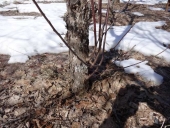I can remember my Dad using a plastic bag to do this 50+ years ago on an indoor plant he liked but which had grown too large for the space available, so the concept's been around a long time!
I think, as with most techniques, it has pros and cons and works better or worse based on the plant, the timing, the weather, one's ability to keep an eye on what's happening etc. A friend used the technique to get me a clone of her Rosemary plant which is so large now it needs a serious pruning, so just as when you take a cutting (which is also a "limb") and stick it in dirt and it grows roots, or if you do the technique at ground level where it's just called "layering", or the variation I do where I choose a branch close to the ground, stick it through a hole in the side of a pot with the leaves sticking out the top and hope it puts roots into the pot, they all work with varying amounts of success.
I feel two key things with air-layering is the ability to keep a close eye on the moisture level in the medium you surround the branch with and the medium you use. Traditionally, peat moss was used, but if it dries out by accident, it's very hard to "re-wet" as dry peat moss almost seems to repel water. (Also peat moss is considered an endangered species particularly on some regions of the planet.) The times I've tried the technique, I've used coir which is a by-product of the palm oil/coconut industry. It has to be shipped long distances, and is not being produced sustainably, so I try to use it only when necessary but it soaks up moisture well and holds it well so I keep some on hand for special situations. If I'm going to get a whole shrub or tree out of a little coir mixed with compost and other goodies, that's a trade off I'm willing to live with.
Trying *all* the different techniques - including starting from seeds as that gives genetic diversity you don't get with cloning - to see which ones work with the particular plant you want to propagate, is a totally worthwhile learning experience because you never know when you might come across a situation where a specific technique will be the best option as a quick solution to a problem that needs fixing. For example, growing lots of biomass on disturbed soil so it won't erode - having lots of self-propagated plants (read "cheap") to plant as soon as possible and not having to worry if they don't all make it is something I wish I'd known I could do on the first property I bought decades ago.
As for the one in your link - $30 for something you can make out of a plastic bottle that could be upcycled to do the same task doesn't appeal to me. That said, at one point I was given a set of these:
https://www.leevalley.com/en-ca/shop/garden/sets/102234-set-of-5-rooter-pots-with-root-stimulator-and-syringe which are $30 Canadian for a set of 5 and are what my friend used to get me a piece of her Rosemary. They are fiddly to use and will only be re-usable a limited number of times, so if you feel you need to start with something commercial, I'd suggest you consider them.

















 1
1
















 1
1








 1
1
















 1
1








